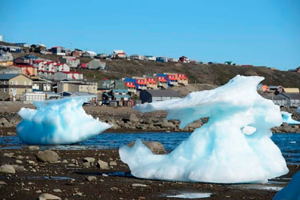
Saturday, August 3, 2019 ~ Nunavut
~ West Shore Voice News
New protections for the High Arctic are intended to boost climate change resiliency and create opportunities for Inuit, it was announced by Prime Minister Justin Trudeau on Thursday August 1 in Iqaluit, Nunavut.
In Canada’s North, rising sea levels and thinning sea ice caused by climate change threaten the lives, cultures, and identities of Inuit – and the survival of the species their communities depend on. That is why the Government of Canada is taking action to address these threats, support new economic opportunities for Inuit, and exceed our goal to protect 10 per cent of Canada’s marine and coastal areas by 2020.
Trudeau, along with the Premier of Nunavut, Joe Savikataaq, and President of the Qikiqtani Inuit Association (QIA), P.J. Akeeagok, announced the first step in the creation of a long term protected area in Canada’s High Arctic Basin – the new Tuvaijuittuq Marine Protected Area. They also announced the completion of the Tallurutiup Imanga National Marine Conservation Area through an Inuit Impact and Benefit Agreement.
Together, these areas cover more than 427,000 sq km, which is larger than Newfoundland and Labrador. Now, nearly 14 per cent of Canada’s marine and coastal areas will be protected – exceeding our target of protecting 10 per cent of Canada’s marine and coastal areas by 2020.
The Inuit Impact and Benefit Agreement supports Inuit stewardship of Tallurutiup Imanga and Tuvaijuittuq. It also creates economic development opportunities in local communities, including Inuit training and employment, through $55 million in Government of Canada funding.
In addition, the Government of Canada is investing in infrastructure for communities in the Tallurutiup Imanga area. These infrastructure investments – which include funding for the construction of harbours and a training centre – total approximately $190 million over seven years.
The Prime Minister also underlined that the government is committed to upholding Canadian sovereignty in the Arctic. The government has made significant investments in the Canadian Coast Guard and Navy, so we have greater capabilities to defend Canada’s national interests.
“The Government of Canada is working to support a healthy Arctic, fight climate change, and advance reconciliation with Indigenous peoples by recognizing their unique relationship with traditional lands and waters and expertise in their management,” it was stated in a news release. “We will continue to work closely with Inuit communities and Northern partners to determine how best to protect our Arctic marine areas for the benefit of all Canadians.”
• Under the Nunavut Agreement, an Inuit Impact and Benefit Agreement must be negotiated with the designated Inuit organization prior to establishing any protected area in Nunavut.
• On April 11, 2019, the Government of Canada, the Government of Nunavut, and the QIA signed a Memorandum of Understanding, committing to work together to explore the potential protection of areas in the High Arctic Basin or Tuvaijuittuq, while supporting the development of a conservation economy.
• Tuvaijuittuq means “the place where the ice never melts” and refers to the area off the northwest coast of Ellesmere Island, Nunavut, in the Arctic Ocean.
• Tuvaijuittuq is the last Arctic area expected to retain year-round sea ice until at least 2050. It is an important area for ice-dependent and culturally important species like polar bears, walruses, and seals as sea ice declines due to climate change.
• The Tallurutiup Imanga National Marine Conservation Area is the primary eastern gateway to the central Arctic for large numbers of migrating marine mammals, and serves as a breeding and foraging habitat for seabird colonies.
• The Government of Canada, with support from provincial and territorial governments, signed and ratified the United Nations Convention on Biological Diversity in 1992. It has since developed a national biodiversity strategy that commits to conserve at least 10 per cent of Canada’s marine and coastal areas by 2020.
• The Government of Canada has designated several marine protected areas in Inuit Nunangat, including the Anguniaqvia niqiqyuam and Tarium Niryutait marine protected areas in the Northwest Territories, and Ninginganiq, Akpait, Qaqulluit, and Nirjutiqavvik national wildlife areas in Nunavut. These areas protect a variety of fish, seabird, and marine mammal species, including important concentrations of beluga and bowhead whales.
• Canada has protection measures in place for 13.81 per cent of our marine and coastal areas, up from around 1 per cent four years ago. Since 2015, Canada has designated:
o 1 national marine conservation area
o 1 marine national wildlife area
o 6 marine protected areas
o 59 marine refuges
• The Tallurutiup Imanga National Marine Conservation Area represents 1.9 per cent of this total, while the Tuvaijuittuq Marine Protected Area represents 5.55 per cent.
• In May 2019, the Government of Canada amended


